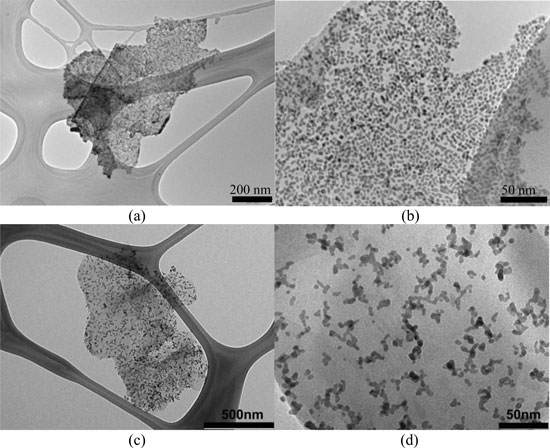| Posted: Sep 08, 2008 | |
Low cost graphite alternative to fabricating nanotechnology biosensors |
|
| (Nanowerk Spotlight) Carbon nanomaterials have been extensively used in electroanalysis, and the most common forms are spherical fullerenes, cylindrical nanotubes, and carbon fibers and blacks. Since the discovery that individual carbon nanotubes (CNTs) can be used as nanoscale transistors, researchers have recognized their outstanding potential for electronic detection of biomolecules in solution, possibly down to single-molecule sensitivity. To detect biologically derived electronic signals, CNTs are often functionalized with linkers such as proteins and peptides to interface with soluble biologically relevant targets (see our Spotlight: Biosensing mechanism with carbon nanotubes explained). | |
| Now, for the first time, scientists have tested nanometal decorated graphene (actually graphite nanoplatelets, a thickness of 10 nm would contain approximately 30 graphene sheets, considering an interlayer spacing of 0.335 nm) in biosensor application. As it turned out, this novel biosensor is among the best reported to date in both sensing performance and production cost. | |
| Researchers have already demonstrated that metal decorated graphene can be an inexpensive alternative to carbon nanotubes and carbon black as support for fuel cell applications (Dissertation: Metal Decoration of Exfoliated Graphite Nanoplatelets (xGnP) For Fuel Cell Application;). | |
| Nanosized functional particles represent an area of great research and commercial interest. In the field of biosensors and biocatalysts, nanosized materials offer the potential for extremely high surface area to volume ratios. This allows the immobilization of large amounts of biomolecules per unit projected area, and can result in high efficiency biosensors or biocatalysts. Unfortunately, the cost of nanomaterials is a big practical bottleneck. In contrast, the graphene based nanomaterials are inexpensive but with high performance. | |
 |
|
| TEM images of 20 wt% platinum-xGnP at (a) low magnification, (b) high magnification, and 20 wt% palladium-GnP at (c) low magnification and (d) high magnification. (Reprinted with permission from American Chemical Society) | |
| "Several previous studies have reported the application of the combination of metal nanoparticles and carbon nanotubes in biosensor application" Dr. Ilsoon Lee tells Nanowerk. "But graphene has unique properties such as the highest thermal oxidation resistance and the highest degree of graphitization compared to carbon nanotube and carbon black that are widely used. Graphene also provides excellent support for nanometal catalysts. We made use of these properties by decorating exfoliated graphite nanoplatelets with platinum and palladium nanoparticles as a transducer for a glucose biosensor." | |
|
Lee, an assistant professor in the Department of Chemical Engineering & Materials Science at Michigan State University, and his team found that xGnP incorporated into the biosensor interface increased the effective electrode surface area and served as an excellent support for metal nanoparticles. The platinum and palladium nanoparticles that were immobilized on the xGnP provided a large electroactive surface area that effectively catalyzed redox reactions involving hydrogen peroxide. "We found that glucose biosensors produced using our approach exhibited a sensitivity up to 61.5 ± 0.6 µA/(mM · cm2) and a response time less than 2 seconds" says Lee. |
|
| "These performance properties are among the best reported to date for glucose biosensors. Both the metal loading and the nanoparticle size (∼ 2 nm) had a significant effect on biosensor performance." | |
| The researcher published their findings in the September 3, 2008 edition of ACS Nano ("Nanometal-Decorated Exfoliated Graphite Nanoplatelet Based Glucose Biosensors with High Sensitivity and Fast Response"). | |
| In previous work ("Simple Fabrication of a Highly Sensitive Glucose Biosensor Using Enzymes Immobilized in Exfoliated Graphite Nanoplatelets Nafion Membrane"), Lee and collaborators have demonstrated that graphene, prepared in one of the coauthors’ (Dr. Drzal) lab at the Michigan State University, can be an inexpensive alternative (∼$10/kg) to carbon nanotubes for use in biosensor application. | |
| Lee explains that the decoration of xGnP with metal nanoparticles further improved their catalytic effects; meanwhile, xGnPs provide high surface area and facilitate uniform distribution of metal nanoparticles, which improved the metal nanoparticle catalyst activity/performance. | |
| To study the storage stability of these new biosensors the researchers stored them dry at 4 °C and studied the response to 0.5 mM glucose intermittently. The response maximized after 1-2 days storage and kept stable for a week. After a week, the response slightly decreased due to the possible leakage of weakly bound enzyme to xGnP. The biosensor could still uphold 70% of the sensitivity after 1 month and 50% in 2 months. | |
| The combination of high performance and inexpensive nanomaterial components – much less expensive than carbon nanotubes – suggests that this approach may be very suitable for commercial applications. | |
| Of course, the incorporation of metal decorated xGnP in biosensor applications would not be limited to glucose biosensing but could be applied to many other biosensors and biocatalytic systems as well. Lee's co-authors Dr. Inhwan Do and Dr. Lawrence Drzal for instance have already applied for a patent on the use of metal decorated xGnP in fuel cells applications. | |
 By
Michael
Berger
– Michael is author of three books by the Royal Society of Chemistry:
Nano-Society: Pushing the Boundaries of Technology,
Nanotechnology: The Future is Tiny, and
Nanoengineering: The Skills and Tools Making Technology Invisible
Copyright ©
Nanowerk LLC
By
Michael
Berger
– Michael is author of three books by the Royal Society of Chemistry:
Nano-Society: Pushing the Boundaries of Technology,
Nanotechnology: The Future is Tiny, and
Nanoengineering: The Skills and Tools Making Technology Invisible
Copyright ©
Nanowerk LLC
|
|
|
Become a Spotlight guest author! Join our large and growing group of guest contributors. Have you just published a scientific paper or have other exciting developments to share with the nanotechnology community? Here is how to publish on nanowerk.com. |
|
